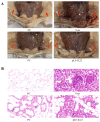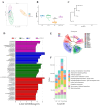In Situ Expression of Yak IL-22 in Mammary Glands as a Treatment for Bovine Staphylococcus aureus-Induced Mastitis in Mice
- PMID: 39453107
- PMCID: PMC11512370
- DOI: 10.3390/vetsci11100515
In Situ Expression of Yak IL-22 in Mammary Glands as a Treatment for Bovine Staphylococcus aureus-Induced Mastitis in Mice
Abstract
Since the development of dairy farming, bovine mastitis has been a problem plaguing the whole industry, which has led to a decrease in milk production, a reduction in dairy product quality, and an increase in costs. The use of antibiotics to treat mastitis can cause a series of problems, which can bring a series of harm to the animal itself, such as the development of bacterial resistance and dramatic changes in the gut flora. However, the in vivo and in vitro antibacterial activity of yak Interleukin-22 (IL-22) and its application in mastitis caused by Staphylococcus aureus have not been reported. In this study, the mammary gland-specific expression plasmid pLF-IL22 of the yak IL-22 gene was constructed and expressed in MAC-T cells and mammary tissue of postpartum female mice. The coding region of the IL-22 gene in yaks is 573 bp, which can encode 190 amino acids, and the homology difference in the IL-22 gene in yaks is less than 30%, which indicates certain conservation. IL-22 is a hydrophilic protein with a total positive charge of four, the presence of a signal peptide, and the absence of a transmembrane domain. Sufficient expression of IL-22 effectively inhibited the high expression of inflammatory factors caused by Staphylococcus aureus, reduced the symptoms of mammary gland histopathology, and alleviated mastitis. Under the action of IL-22, the intestinal flora of mastitis mice also changed, the abundance of intestinal Bacilli, Prevotellaceae, and Alloprevotella in mice increased after treatment, and the pathogenic bacteria decreased. These findings provide new insights into the potential application of the yak IL-22 gene in the treatment of bovine mastitis in the future.
Keywords: IL-22; Staphylococcus aureus; anti-inflammatory; intestinal flora; mastitis.
Conflict of interest statement
The authors declare no conflict of interest.
Figures







Similar articles
-
Directed Expression of Tracheal Antimicrobial Peptide as a Treatment for Bovine-Associated Staphylococcus Aureus-Induced Mastitis in Mice.Front Vet Sci. 2021 Oct 4;8:700930. doi: 10.3389/fvets.2021.700930. eCollection 2021. Front Vet Sci. 2021. PMID: 34671659 Free PMC article.
-
Single-Chain Fragment Variables Targeting Leukocidin ED Can Alleviate the Inflammation of Staphylococcus aureus-Induced Mastitis in Mice.Int J Mol Sci. 2021 Dec 29;23(1):334. doi: 10.3390/ijms23010334. Int J Mol Sci. 2021. PMID: 35008761 Free PMC article.
-
Protein Expression Profiles in Exosomes of Bovine Mammary Epithelial Cell Line MAC-T Infected with Staphylococcus aureus.Appl Environ Microbiol. 2023 Apr 26;89(4):e0174322. doi: 10.1128/aem.01743-22. Epub 2023 Mar 20. Appl Environ Microbiol. 2023. PMID: 36939340 Free PMC article.
-
Staphylococcus aureus metal acquisition in the mastitic mammary gland.Microb Pathog. 2020 Jul;144:104179. doi: 10.1016/j.micpath.2020.104179. Epub 2020 Mar 31. Microb Pathog. 2020. PMID: 32244043 Review.
-
Nutrient sensing mechanism of short-chain fatty acids in mastitis control.Microb Pathog. 2022 Sep;170:105692. doi: 10.1016/j.micpath.2022.105692. Epub 2022 Jul 31. Microb Pathog. 2022. PMID: 35921952 Review.
References
-
- Zaatout N., Hezil D. A meta-analysis of the global prevalence of methicillin-resistant Staphylococcus aureus (MRSA) isolated from clinical and subclinical bovine mastitis. J. Appl. Microbiol. 2022;132:140–154. - PubMed
-
- Dahl M.O., De Vries A., Maunsell F.P., Galvao K.N., Risco C.A., Hernandez J.A. Epidemiologic and economic analyses of pregnancy loss attributable to mastitis in primiparous Holstein cows. J. Dairy Sci. 2018;101:10142–10150. - PubMed
LinkOut - more resources
Full Text Sources

